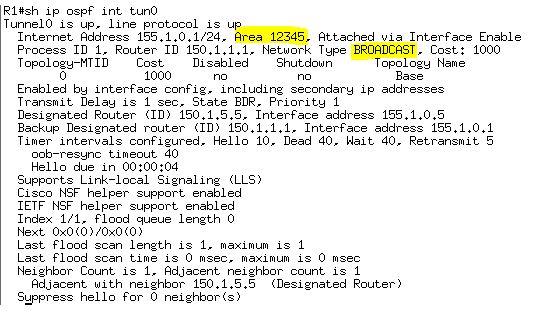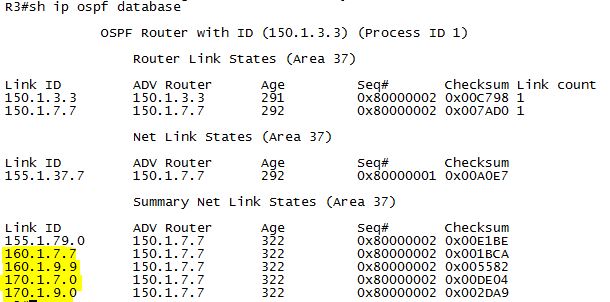OSPF is sometimes
described as being partially link-state and partially distance vector. This is
because SPF calculations are only performed for Intra-Area routing, whereas the
Area Border Routers’ (ABRs) advertised information is trusted for Inter-Area
and External calculations. R10 does not know the detailed information about the
path selection that is occurring behind R5 (ABR). R10 trusts R5’s calculation
for the prefix, which is typically a distance vector behavior, and then
calculates the shortest Intra-Area path to reach R5, which is a link-state
behavior.
Metric of the route is 41 and it’s an ospf inter-area route.
Next hop is 155.1.108.8 and the route is from 150.1.5.5 with the cost of 21.
First finding out who R10 is
adjacent with by viewing its Router LSA (LSA 1).
So, from above total
cost from R10 to 150.1.6.6 is 21+10+10=41.
Now, let’s see how R5
gets the cost of 21.
To view possible paths
to Network Summary LSA (LSA 3), below shows both R1 and R4 with advertising
cost of 11.
To find shortest path cost
to R1 and R4,
The cost to reach all
ABR routers can also be identified from the following output.
Setting a ospf cost for
an interface is only effective for its router’s shortest path calculation; not
the directly connected router at the other end of the interface. OSPF cost
calculation for a segment is based on the bandwidth value of the outgoing
interface.
To have different OSPF
cost per neighbor, the network type’s point-to-multipoint and
point-to-multipoint non-broadcast support the setting of the OSPF cost value on
a per-neighbor basis.
---------------------------------------------------------------------------------------
Inter-area routing can
only occur through area 0.
Non-backbone (not area 0)
areas can be used for inter-area transit if a shorter path can be found through
them, and if the "TransitCapability parameter has been set to TRUE in Step
2 of the Dijkstra algorithm." In Cisco’s IOS implementation, this flag is controlled
with the capability transit routing process-level
command, and is on by default. The design case when the feature is used is very
specific and has to do with a shorter Inter-Area path being found via a
non-area 0 router as compared to the target router of a virtual-link.
Flooding Reduction – LSA’s
LS age is never incremented past the value MaxAge. When the link state age
reaches MaxAge, the router must attempt to flush the LSA by reflooding the
MaxAge LSA just as if it was a newly originated LSA. MaxAge value is 3600 sec or 60 minutes by default. To ensure the an
LSA is not aged out, which means it will be flushed from the OSPF database,
each LSA is reflooded after 30 minutes,
regardless of whether the topology is stable or not. This periodic flooding
behavior is commonly referred to as the “paranoid update.” The ip ospf
flood-reduction feature stops unnecessary LSA flooding by setting the DoNotAge
(DNA) bit in the LSA, removing the requirement for the periodic refresh. This
needs to be enabled on links with OSPF neighbors attached.
OSPF Summarization
Because devices in an
OSPF area require the same copy of the database to compute correct SPF,
filtering or summarization of routes in the database can only occur between
areas or domains, not within an area. Use "area <area no from where
routes summarized> range address mask".
External OSPF
summarization is configured at the redistribution point between routing domains
with the summary-address command.
The Forward Address:
0.0.0.0 field means that R5 must now compute the metric toward the advertising
router, ASBR, and install this metric in the routing table as the forward
metric.
The calculation for
External Type-1 OSPF routes does not distinguish in the routing table between
the metric reported by the ASBR and the metric to the ASBR via the forward
metric. Instead, External Type-1 routes represent the metric as one cumulative
value of the reported metric and the metric to the ASBR.
OSPF Stub Area
The stub area, is used
to remove Type-5 External link states from the database and replace them with a
default route. When an OSPF router redistributes a route into the domain, it
originates a Type-5 External LSA representing the route and its attributes.
Inside this LSA, the originating router sets the advertising router field to
its local router-id and, generally, the forward address field to 0.0.0.0. When
an OSPF router in the same area as the originator looks up the Type-5 LSA, it
looks at the forward address. If the forward address is set to 0.0.0.0, it
means that the traffic should be sent toward the advertising router to reach
the destination. To find out how to reach the advertising router, the
advertising router’s Type-1 Router LSA is consulted, and intra-area SPF is
performed. This is similar to inter-area routing logic, because the router
doing the lookup does not compute SPF to the final destination, only the intermediary
advertising router.
For external routing
between areas, the logic is modified slightly. When an Area Border Router
receives a Type-5 External LSA from a device in its own area and passes it into
a different area, a Type-4 ASBR Summary LSA is generated. The Type-4 LSA tells
devices in the new area how to forward toward the ASBR, which in turn tells
them how to forward toward the external route.
OSPF NSSA
When the Type-7 NSSA
External LSA is received by the ABR and is moved into area 0, the information
contained in the Type-7 LSA is translated to a normal Type-5 External LSA. If
multiple ABRs exist, only one of them performs the translation through an election
process.
Note that ABR R5
receives the Type-7 NSSA External LSA with the forward address set to
150.1.8.8. With the previous Type-5 external lookups, we saw the forward
address set to 0.0.0.0, which meant to route toward the advertising router to
reach the final destination. In this case, the forward address is non-zero,
which causes the lookup to be performed toward 150.1.8.8. This is a subtle
difference in the lookup process and there can, however, be certain designs
where there is a shorter path to the forward address than the advertising
router’s address.
The other key difference
between stub and NSSA areas is how default routing works. The stub area removes external Type 3 LSAs
and replaces them with a default route. The totally stubby area extends this by replacing external Type 3 LSAs
and inter-area Type 2 LSAs with a default route. However, with the NSSA, a default route is not
automatically originated by the ABR. This means that devices within the NSSA
will have reachability to their own area and to other areas, but not to destinations
outside of the OSPF domain.
Using default
information-originate option onto the area [id] nssa statement, the default
route is injected by the ABR as a regular Type-7 LSA with the type of N2 which
uses the metric advertised by the ABR and the forwarding metric as the cost
towards the ABR.
The not-so-totally-stubby area is the combination of the
totally-stubby area and the NSSA. Like the totally-stubby area, Type-3 Summary
LSAs, Type-4 ASBR Summary
LSAs, and Type-5 External LSAs are removed and replaced with a Type-3 Summary
LSA default route. Like the NSSA, Type-7 NSSA External LSAs are allowed to be
originated inside the area.
OSPF always prefers routes
in the sequence intra-area> inter-area > external > nssa-external.
----------------------------------------------
----------------------------------------------
With OSPF Not-So-Stubby
Areas, Type-7 NSSA External LSAs are translated to Type-5 External LSAs by the
ABR connecting the NSSA to area 0. When multiple ABRs connect the NSSA to area
0, the ABR with the highest router-id is elected as the Type-7 to 5 translator,
and is responsible for re-originating the Type-5 LSA into area 0.
Only one ABR performs
the Type-7 to 5 translation, but maintains the forward address field, essentially
separating the relationship between the routing advertisement and the traffic
flow.
Type-5 External route
that was translated from a Type-7 NSSA External route does not use a Type-4
ASBR Summary LSA, because the forward address lookup replaces the need for the
ASBR Summary lookup. Because the forward address is preserved, only one router
needs to do the translation, while the calculation of the final forwarding path
stays independent. The control plane advertisement of the route does not need
to follow the traffic forwarding plane.
By adding the
no-redistribution keyword onto the area 3 nssa statement of R5, Type-7 LSAs are
not generated for locally redistributed routes. This does not, however, prevent
other devices inside the NSSA from performing redistribution.
OSPF Filtering
A very specific feature
- OSPF Forwarding Address Suppression in Translated Type-5 LSAs can be
configured by adding "translate type7 suppress-fa" argument to
"area 3 nssa" statement to instruct the ABR to not preserve the value
in the forward address field as a Type-7 NSSA External LSA is translated into a
Type-5 External.
All routers within an
OSPF area must agree on their view of the database and hence, OSPF
filtering in the database can be accomplished between areas, but not within an
area. Inter-area filtering has been previously demonstrated with stub areas,
and the Type-3 LSA Filter (filter list). Intra-area filtering can be
accomplished in OSPF with an inbound distribute-list; however, this filtering
only affects the local routing table, not the OSPF database. This type of
design can result in traffic black holes if not implemented carefully.
After implementing
distribute-list inbound, the prefix/route is not installed in the routing table
but it’s in the OSPF database.
With a normal
distribute-list filter referencing an access-list, there would be no way to
distinguish between the same prefix from 2 neighbors because they are the same
prefix, just two different paths in the network. Referencing a route-map with a
distribute-list in OSPF extends the filtering capability with additional match
criteria such as route-source, next hop ip, etc.
OSPF Default Routing
Default routing for
non-stub areas in OSPF is accomplished through the origination of Type-5 External
LSAs via the default-information originate command. Without any additional
arguments, the OSPF process first checks to see if a default route is installed
in the routing table. If a default route is already installed, such as via a
static route or learned via BGP, the OSPF default route is originated. If the
default route is not found, no origination occurs. This behavior is typically
desirable in designs with multiple exit points out of the OSPF domain to
upstream networks. This behavior can be modified by adding the always argument
to the default-information originate statement, which essentially skips the
checking for a default route already being installed in the table.
The automatic
origination of the discard route
can be disabled with the “no discardroute [internal | external]”, where
internal refers to inter-area summarization performed with the area range
command, and external refers to redistributed summarization performed
with the summary-address command on the ASBR for NSSA type 7 to type 5
translation.
A neighbor relationship
cannot occur if two OSPF neighbors have different MTU values on their
interfaces. If the MTU difference is by design, the interface-level command ip
ospf mtu-ignore removes this requirement from the adjacency establishment.










































